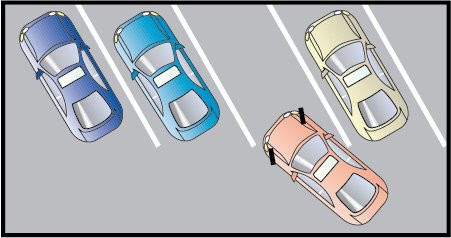On This Page
There are different types of parking. When leaving a parked or stopped position, check your blind spots and mirrors, and yield to all other traffic.
Park in the direction vehicles are moving in the lane. Park parallel to and no more than 12 inches from the curb. If there is no curb, park as close as possible to the edge of the shoulder. If parking areas are marked, your wheels must be within the marked space.

This type of parking is common in parking lots, shopping centers, and on wide streets.
When driving large vehicles avoid parking in spaces that obstruct traffic on the road.
Signs may be posted to indicate when a parking area is reverse angle or back-in only.
Always set your parking brake. Leave your vehicle in gear if it has a manual transmission or in park for an automatic transmission. Turn your front wheels as indicated below to prevent your vehicle from rolling downhill in case the brake fails.
Downhill Against a Curb
Turn your wheels toward the curb.
Uphill Against a Curb
Turn your wheels toward the travel lane.
No Curb
Turn your wheels toward the edge of the road.

 Oregon issues special parking permits to persons with disabilities or groups that transport persons with disabilities. Spaces may have the disabled symbol on the ground as well as a sign with the symbol placed at the front of each space.
Oregon issues special parking permits to persons with disabilities or groups that transport persons with disabilities. Spaces may have the disabled symbol on the ground as well as a sign with the symbol placed at the front of each space.
It is illegal to park in a space marked for persons with disabilities unless you have a valid disabled parking permit.
The rules about parking and stopping apply whether you are in your vehicle or not. You cannot stop or park your vehicle in any of the
locations identified below. This does not apply if your vehicle breaks down and you cannot get it out of the traffic lanes or there is not
enough room off the road on the shoulder for you to stop or park.
- In a traffic lane, on a highway, street or road.
- Within an intersection.
- On the road side of any parked vehicle (double parking).
- On a sidewalk, crosswalk, bicycle lane or path.
- On any railroad or light rail tracks.
- On a bridge, overpass, or in a tunnel.
- Between separate roads of a divided highway.
- Near construction or road work when stopping or parking would interfere with traffic.
- Any place where official signs, traffic control devices, painted diagonal stripes, or other pavement markings prohibit parking.
- In front of a public or private driveway.
- Within 10 feet of a fire hydrant.
- Within 15 feet of the driveway entrance to a fire station on the same side of the street or within 75 feet on the opposite side of the street.
- Within 20 feet of a marked or unmarked crosswalk at an intersection.
- Within 50 feet of a traffic signal or sign if your vehicle hides the signal or sign from view.
- Within 50 feet of the nearest rail of a railroad or light rail crossing.
- Within 7 1/2 feet of railroad or light rail tracks when it interferes with the train.
If your vehicle breaks down and you have no choice, you may temporarily stop or park in areas where it usually is not allowed, as long as the vehicle does not create a hazard. If you must stop or pull off the road, turn on your hazard lights to warn other drivers.
If necessary, you may park a vehicle on the shoulder of a highway if passing traffic has enough room to get by. If your vehicle cannot be seen from 200 feet in each direction, you need to warn approaching traffic. This can be done with flags, flares, signs, signals or flaggers placed at least 200 feet from your vehicle in each direction.
If you must leave your vehicle unattended, turn off the engine, remove the key, set the brakes, and turn on your hazard lights.
If a police officer finds a vehicle parked in an area where it is not allowed or it creates a hazard, the officer may have it removed and you will be responsible for towing and storage costs.

- When you parallel park, you need to be no more than ___ inches away from the curb.
- 12
- 10
- 8
- What is the safest way to re-enter traffic from a parked position?
- Yield to other traffic after you signal and check your blind spots and mirrors.
- Signal, check your blind spots and pull into other traffic.
- Check all your mirrors and signal, other traffic will yield to you.